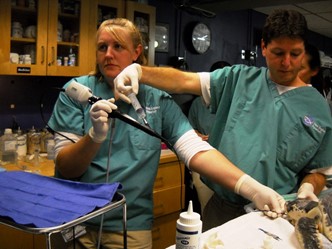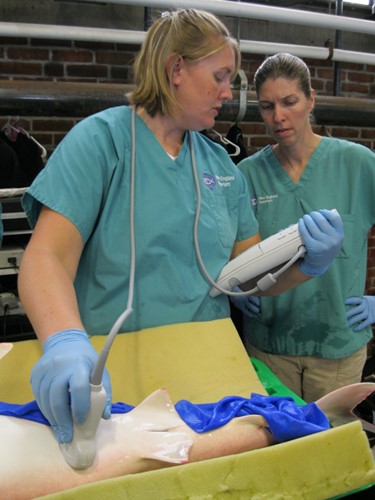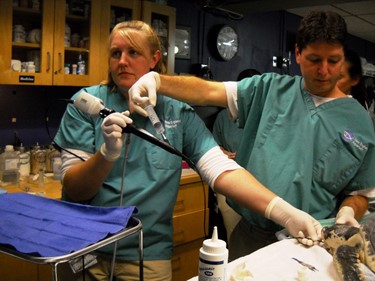Dr. Julie Cavin
 Dr. Julie Cavin, Veterinarian at Gulfarium CARE Center in Fort Walton Beach, FL, graduated from FSU in 2001 with a degree in Biological Science and a Certificate in Living Marine Resources Ecology. She received her veterinary degree from North Carolina State University in Raleigh, NC, and then completed a veterinary internship at Georgia Aquarium in Atlanta, GA. She is also the lead veterinarian for the Gulfarium Marine Adventure Park where she cares for animals ranging from marine mammals, sharks and stingrays, fish, birds, and reptiles! We are so grateful for all she does for our animals.
Dr. Julie Cavin, Veterinarian at Gulfarium CARE Center in Fort Walton Beach, FL, graduated from FSU in 2001 with a degree in Biological Science and a Certificate in Living Marine Resources Ecology. She received her veterinary degree from North Carolina State University in Raleigh, NC, and then completed a veterinary internship at Georgia Aquarium in Atlanta, GA. She is also the lead veterinarian for the Gulfarium Marine Adventure Park where she cares for animals ranging from marine mammals, sharks and stingrays, fish, birds, and reptiles! We are so grateful for all she does for our animals.
She has authored and co-authored numerous papers and given multiple presentations and lectures. She taught fish medicine to veterinary students at Tufts Cumming School of Veterinary Medicine and co-taught a course in sea turtle medicine in the Aquavet I summer program at Cornell University. She has worked at Gulf World in Panama City, FL, the New England Aquarium, and South Carolina Aquarium.
Growing up in the panhandle of Florida, just 60 miles west of Tallahassee, Julie was a water baby from birth. When she started SCUBA diving at the age of 13, she knew that she wanted to have a career working with the ocean. After a few years, she discovered that “marine mammal veterinarian” was a real job and was hooked. Having FSU alumni as parents, Julie was born and raised a Seminole, so attending Florida State for undergrad was an obvious choice, especially given her desire to gain experience with aquatic animals and ecology.

Julie’s introduction to the world of research occurred when she worked for two years in the lab of Drs. Felicia Coleman and Chris Koenig. She assisted with a trophic (i.e. feeding and nutritional) study on snook and red drum fish in Florida Bay by removing otoliths (i.e. fish ear bones) and stomachs from numerous fish, and returned calls regarding goliath grouper sightings. She also took as many classes in marine science as would fit in her schedule with the required pre-vet courses.
“One of my all time favorite classes was Invertebrate Zoology with 'Doc' Bill Herrnkind. We would spend two days a week at the FSU Marine Lab conducting research on the snails, oysters, lobsters and everything else that lives just off the dock. Those were some of my best memories of FSU; sloshing around in the marshes and watching pea crabs move from one sand dollar to the next. I’m pretty sure I even told ‘Doc’ that I wanted him to be my grandpa,” Julie recalls.
Those were some of my best memories of FSU; sloshing around in the marshes and watching pea crabs move from one sand dollar to the next [with Doc Herrnkind].
While at FSU, Julie received the FSU William R. and Lenore Mote Scholarship in Marine Biology, which allowed her to intern at Mote Marine Laboratory in Sarasota, Florida in the fisheries department.
“I loved my time at Mote so much, that I applied for an internship in the Dolphin and Whale Hospital the next summer. Those internships allowed me to gain a wide range of experience which helped further my career. None of that would have been possible without FSU.”

Through her experiences during undergrad and since, Julie became passionate about the health and management of elasmobranchs (e.g. sharks, rays, and skates) both in the wild and in human care.
“While most aquariums throughout the world have at least one species of either shark or stingray in their collection, our knowledge of their normal physiology is still very limited. Each species of fish - boney or cartilaginous - has its own environmental and nutritional requirements. They often react to medication different including antibiotics and anesthesia. Our care of all aquatic animals has improved tremendously in the last few decades, but we often still do not even know what is ‘normal’ for a given species. One of my career goals is to help increase the number of hematological and biochemical reference ranges (i.e. red and white blood cells numbers, glucose and sodium levels, etc.) for elasmobranchs,” explains Julie.
In September 2015, Julie joined a group of scientists from multiple institutions on an expedition to the Phoenix Islands Protected Area (PIPA) in Kiribati. During that trip, she collected blood samples from nearly 200 sharks to create reference ranges for wild blacktip reef sharks and grey reef sharks (see video below of Julie's talk).

Working at various aquatic facilities has also given Julie a unique experience to work with hundreds of unique and endangered aquatic animals including sea turtles from newly hatched loggerhead turtles weighing a few grams to leatherback turtles weighing over 500 kg and a 5 cm long pearl fish that lives in a sea cucumber orifice to Japanese spider crabs that can get nearly the size of a car.
"I have been so fortunate to work with animals that most people have never seen or even heard of before. I love watching people, especially kids, experience these animals for the first, and maybe only, time. As has been said, ‘we protect what we love, and we love what we know.' People will not protect the ocean unless we help them to experience it. That’s why I am so passionate about my job and the FSU Marine Lab. To this day, I tell people that attending FSU was one of the best decisions of my life. Working with Chris and Felicia literally started me on the path to where I am today."
To learn more about the research conducted by the 2015 PIPA (Phoenix Islands Protected Area) Expedition Team, watch the video where Dr. Julie Cavin presents her work on "Reef Shark Hematology"(starts at 20:00). Also read about Dr. Cavin's work rehabilitating Sea Turtles here.

